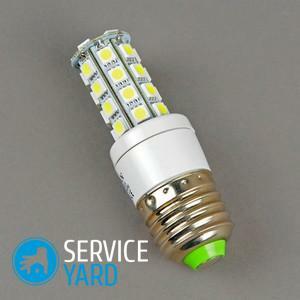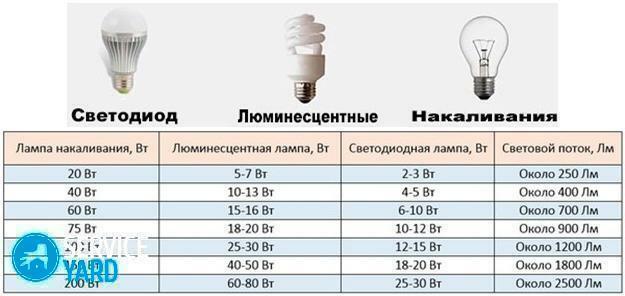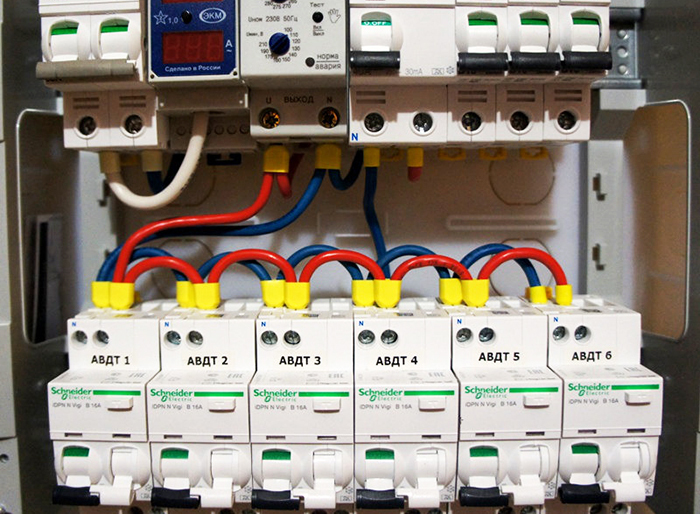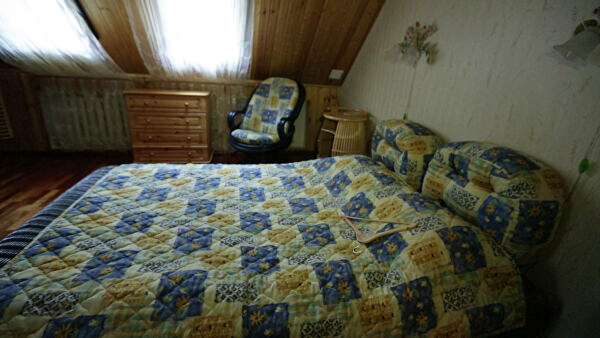
- Construction of LED bulbs
- Pros and cons of LED lamps
- Lamps for LED: how to choose?
- Manufacturers
- Warranty
- What else to look for when choosing LED lamps for the home?
LED lamps are one of the most environmentally friendly light sources and are the newest alternative to obsolete incandescent lamps. Such lamps do not contain mercury-containing elements, so they do not pose a threat and danger to humans. The range of LED lamps has significantly expanded recently, so it is so important to know how to choose LED lamps for the home, what parameters of products affect the comfort of lighting, saving electricity and cost. Today we will try to understand as thoroughly as possible all the nuances of choosing products.
to content ↑Construction of LED lamps
The product design has three main elements:
- The LED is a light source. LEDs have different layouts. Some lamps consist of only white LEDs, others - from blue.
Important! Lamps consisting of several white light sources are ineffective and quickly break down. It is best to choose a lamp with several blue LEDs and necessarily covered with phosphorus. It is this mixture that gives a very bright white light.
You can choose a lamp and a LED home lamp with one, but a super-power white LED.
- Mini transformer. Since the usual home electrical network has a voltage of 220 V, and for the light emitting of the LEDs only 12 V DC is needed, then the light bulb must have a transformer that converts the voltage. This is the most vulnerable part of the product and the most expensive, so that if the transformer is of poor quality, the light bulb will not work for a long time.
- Cooling radiator, which is designed to cool a permanently heated transformer. When choosing a product, you must pay attention to the fact that the radiator has good ventilation.
Important! How not to doubt the quality and make the right choice of LED lamps for the house:
- If the design does not provide a cooling system in the form of a finned radiator, then bypass this model of the lamp side.
- Sometimes manufacturers instead of an aluminum radiator install plastic. Do not buy this model, because plastic has many disadvantages, in addition, it does not have such a high cooling efficiency.
- Please note when choosing a product and at this time: the matt flasks of the product do not allow you to see if there is a cooling radiator in the lamp or not. Stop your choice on transparent lamps to fully verify the quality of the product.
Pros and cons of LED lamps
In times of constant increase in tariff prices for electricity, each person is trying to find ways to save money. One such method is the replacement of conventional fixtures with LEDs. In addition, these light sources have a number of advantages. Here are just a few of them:
- Long service life. Compare yourself:
- average life of incandescent lamps 1000 hours;
- energy-saving - 10,000 hours;
- LED - 50 thousand hours, which corresponds to 10-12 years of continuous operation.
- Very high efficiency. Unlike incandescent bulbs, 97% of the LEDs are used for lighting, not for heat.
- Low power consumption. The level of electricity consumption for LED lamps is 10 times less than for incandescent lamps.
- Environmentally friendly. Unlike energy-saving light sources, LED light fixtures do not contain toxic harmful substances and do not harm either the person or the environment.
- Wide range of applications. Devices of this type are used not only as a primary or additional light source. LEDs are also used for lighting interior items, in night lamps and table lamps, as well as in flashlights.
- No heating time.
- Efficient and high-quality work, even at low temperatures. Such lamps can be safely used to illuminate the yard of the house in the coldest winter.
- Lamps do not emit ultraviolet light. This allows you to use them in special rooms, for example, in art galleries, where a regular light bulb can negatively affect the paint of paintings.
Important! The only drawback of LED devices is their high price. However, in the advisability of using these light sources there is no doubt, and the merits of LED lamps are much greater.
to the contents ↑Lamps for LED: how to choose?
In principle, LED lamps for an apartment to choose is not difficult, you only need to pay attention to three factors:
- Power.
- Type of cap and lamp shape.
- Manufacturer and warranty of service life.
Consider how to choose LED lamps for your home, depending on the characteristics of the product.
Power
The most important characteristic for LED light bulb buyers is the power. This parameter for LED lamps differs significantly from the performance of conventional light bulbs. The power of the LED devices starts at 5.5 watts and ends at 25 watts.
Important! When replacing conventional light sources with LED products, the power of the current version should be reduced by 5 times. For example:
- If you had a regular 75 W bulb, then the LED analogue should be selected with a power of not more than 15 watts.
- The 25 W LED indicator for a light bulb corresponds to 150 watts of a normal light source.
When choosing the power of a light bulb, you need to determine the level of brightness of light. For example, for a house and an apartment there is enough power in a 6-8 W LED bulb. Such light sources will provide a cozy and even light, better than 60-watt incandescent lamps.
Tips:
- When choosing the number of light sources, proceed from the fact that on 3 sq.m. Only one LED lamp is needed.
- There are LED bulbs that operate between 12 and 220 V. The first option is used for rooms with high humidity, for example, for lighting in the bathroom.
- Another parameter must be chosen wisely - this is the color temperature of the diode. Remember that the higher the temperature in Kelvin( K), the colder the glow.
Important! Do not choose LED lamps with bright daylight, as they are designed for offices and industrial premises. It is better to choose a light source in the range of 2700-3000 K. It is this temperature interval that represents the usual yellowish solar glow.
Pay attention to the packaging of the product, where the lamp color can be indicated in the verbal form. Choose "warm white" or "soft white" color. 
Socket type
Different types of socle are used for household lamps. The main ones are as follows:
- E27 - standard. A lamp with such a cap simply screwed into the lamp holder.
- E14 - a small socle for lamps "Mignon".Use such lamps in sconces and nightlights.
- GU10 - mainly used for spotlights. Such a base consists of two pins with an extension at the end. A lamp with this type of cap is installed with a turn, which ensures the reliability of its mounting in the chuck.
- GU5,3 - used for spotlights. The difference with GU10 is only in the thickness of the pins. A lamp with this type of cap is installed without turning. The operating voltage of such light sources is basically 12 V.
- T8 - is installed on the lamps, which are designed to replace tubular fluorescent lighting devices. The length of lamps of this type is 0.6 and 1.2 m.
- G9 - is used when replacing single halogen lamps. This type of socle consists of two arches bent into an arc. The main area of application of such products is decorative spotlights.
Important! When choosing a LED light bulb, it is better to stay on the version of the socle that was earlier. For example, if the chandelier has a standard E27 base, then look for the LED with the same parameter.
Shape and features of the lamp assembly
The shape of the light sources can vary greatly:
- Pear-shaped.
- Round.
- Stretched.
- In the form of a candle or a cob of corn.
- In the form of a tablet.
Important! When choosing the shape of the product, rely on your preferences and design of the room.
Lamps can also differ in design, for example, there are open and closed lamps:
- The open type immediately indicates the quality of the product. They should not be bought - such lamps quickly deteriorate.
- Buy closed lamps. The most qualitative of these are products with a super-power LED or a few blue-spectrum LEDs covered with phosphorus. This option is the most durable in terms of service life.
Manufacturers of
It's no secret that the quality and the guarantee of the durability of any device depend on the manufacturer. If you choose LED lamps for your home from a proven brand, you can be sure that the devices will last long enough, and money will not be thrown away.
To date, both domestic and foreign companies produce quite reliable products.
The leaders of the ratings are the following giants:
- Philips( Holland).
- Osram( Germany).
- Nichia.
- GREE.
- Gauss.
Important! All these companies are profiled in the production of light and electrical equipment.
The following companies have proved to be successful from domestic manufacturers:
- "Svetlana-Optoelectronics".
- "Optogan".
Important! A lot of positive reviews, recently, about the Chinese company Maxus. It is her products that have the highest warranty period, moreover, at a relatively low price.
to the contents ↑Guarantee
When choosing LED devices, pay attention to the characteristic as a working resource. Today, this figure can exceed the bar in 50 thousand hours, and this - about 15 years of work. However, do not rely heavily on the reliability of information from manufacturers, since over time, the quality of LEDs glows noticeably decreases.
It's best to start off from the warranty period of operation. This time can be as long as 3 years, and 5 years. And this means the following: if the lamp for this period of time breaks down, then you can replace the product with a new one for free.
to the contents ↑What else to look for when choosing LED lamps for the home?
There are a few more nuances that can not be ignored if you decide very scrupulously to solve the problem and choose LED lamps for a house of really good quality:
- Angle of light scattering. The nature of the illumination will depend on whether the scattering lens is installed in the lamp and whether it is coated from inside with phosphors.
- Position. Pay attention also to how the LEDs in the lamp are located:
- if they are in the same plane, then the light will be narrow;
- multi-level deployment will create diffuse lighting.
- Light transmittance. For bright illumination, this indicator should be not less than 80. A high indicator is the coefficient 95, but the price of such a model will be more expensive.
Important! The color reproduction is indicated on the package.
- Dimmers. If you replace conventional switches with dimmers that allow you to smoothly adjust the brightness of light, remember that not all LED light bulbs can approach the dimmer. LEDs for connection to the dimmer must be specially designed, otherwise - and dimmer, and the lamps quickly fail.
- Exterior design. Very much about the quality of the product itself says the packaging itself. The popular manufacturers usually display the following data:
- Information about the manufacturer.
- Warranty period of work.
- Power.
- Color temperature( in Kelvin or in verbal form).
- Type of cap.
- Light output( in Lumens).
- Color rendition coefficient.
- Barcode.
- Appearance. The lamp should be smooth, without any roughness or burrs. All fastening elements must be made without gaps and unevenness, and also without protruding wires.
We hope that our information has helped you to choose a quality light source, thanks to which comfortable lighting will appear in the house. And as a bonus - saving electricity and money.



